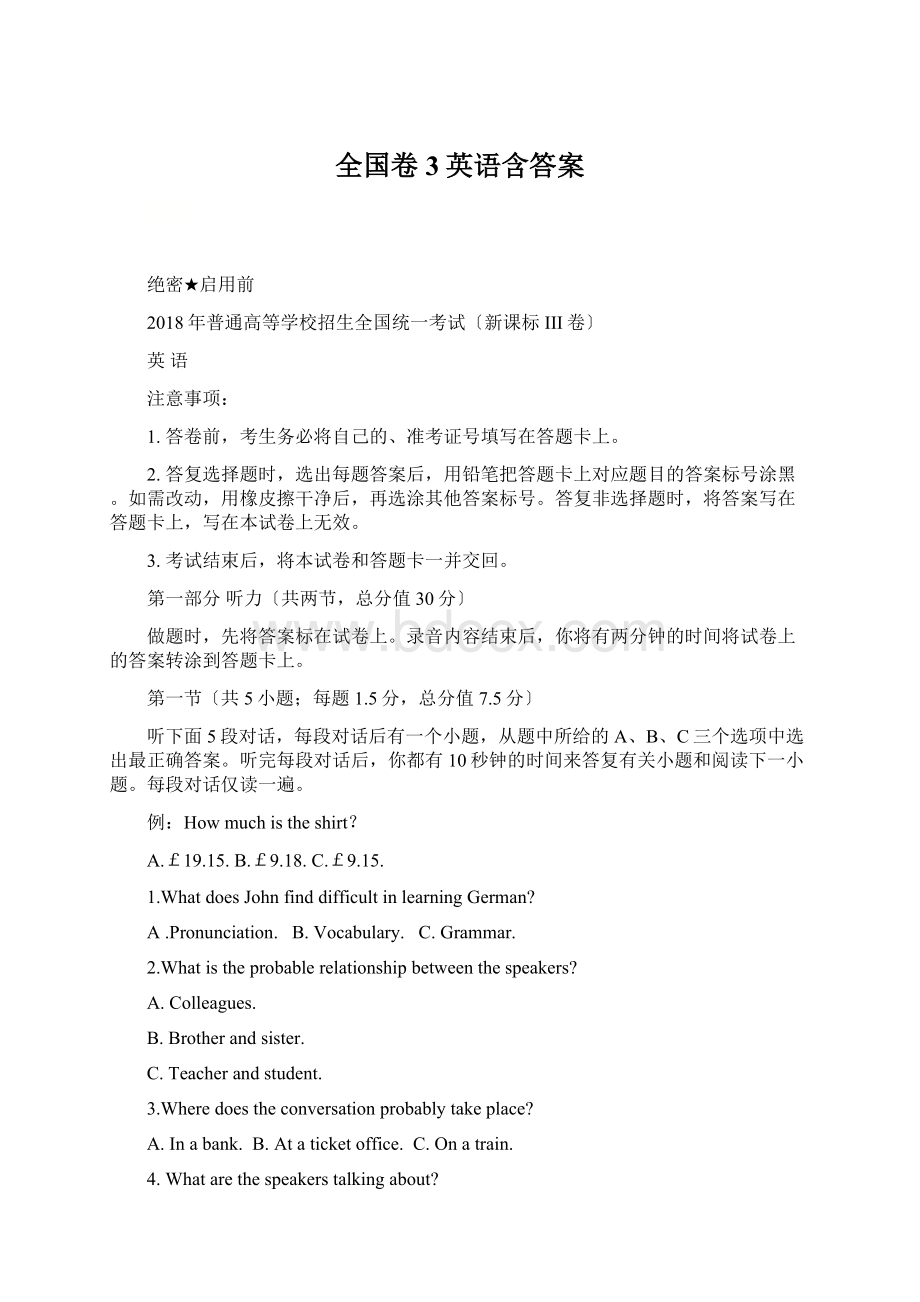全国卷3英语含答案.docx
《全国卷3英语含答案.docx》由会员分享,可在线阅读,更多相关《全国卷3英语含答案.docx(12页珍藏版)》请在冰豆网上搜索。

全国卷3英语含答案
绝密★启用前
2018年普通高等学校招生全国统一考试〔新课标III卷〕
英语
注意事项:
1.答卷前,考生务必将自己的、准考证号填写在答题卡上。
2.答复选择题时,选出每题答案后,用铅笔把答题卡上对应题目的答案标号涂黑。
如需改动,用橡皮擦干净后,再选涂其他答案标号。
答复非选择题时,将答案写在答题卡上,写在本试卷上无效。
3.考试结束后,将本试卷和答题卡一并交回。
第一部分听力〔共两节,总分值30分〕
做题时,先将答案标在试卷上。
录音内容结束后,你将有两分钟的时间将试卷上的答案转涂到答题卡上。
第一节〔共5小题;每题1.5分,总分值7.5分〕
听下面5段对话,每段对话后有一个小题,从题中所给的A、B、C三个选项中选出最正确答案。
听完每段对话后,你都有10秒钟的时间来答复有关小题和阅读下一小题。
每段对话仅读一遍。
例:
Howmuchistheshirt?
A.£19.15.B.£9.18.C.£9.15.
1.WhatdoesJohnfinddifficultinlearningGerman?
A.Pronunciation.B.Vocabulary.C.Grammar.
2.Whatistheprobablerelationshipbetweenthespeakers?
A.Colleagues.
B.Brotherandsister.
C.Teacherandstudent.
3.Wheredoestheconversationprobablytakeplace?
A.Inabank.B.Ataticketoffice.C.Onatrain.
4.Whatarethespeakerstalkingabout?
A.Arestaurant.B.Astreet.C.Adish.
5.Whatdoesthewomanthinkofherinterview?
A.Itwastough.B.Itwasinteresting.C.Itwassuccessful.
第二节〔共15小题;每题1.5分,总分值22.5分〕
听下面5段对话或独白,每段对话或独白后有几个小题,从题中所给的A、B、C三个选项中选出最正确选项。
听每段对话或独白前,你将有时间阅读各个小题,每题5秒钟;听完后,各小题将给出5秒钟的作答时间。
每段对话或独白读两遍。
听第6段材料,答复第6、7题。
6.WhenwillJudygotoaparty?
A.OnMonday.B.OnTuesday.C.OnWednesday.
7.WhatwillMaxdonext?
A.Flyakite.B.Readamagazine.C.Dohishomework.
听第7段材料,答复第8、9题。
8.Whatdoesthemansuggestdoingatfirst?
A.Goingtoaconcert.
B.Watchingamovie.
C.Playingacomputergame.
9.Whatdothespeakersdecidetodo?
A.VisitMike.B.Goboating.C.Takeawalk.
听第8段材料,答复第10至12题。
10.Whichcolordocatsseebetterthanhumans?
A.Red.B.Green.C.Blue.
11.Whydocatsbringdeadbirdshome?
A.Toeattheminasafeplace.
B.Toshowofftheirhuntingskills.
C.Tomaketheirownershappy.
12.Howdoesthemansoundattheendoftheconversation?
A.Grateful.B.Humorous.C.Curious.
听第9段材料,答复第13至16题。
13.WhoisMacy?
A.Ed’smother.B.Ed’steacher.C.Ed’sfriend.
14.HowdoesEdusuallygotokindergarten?
A.Bycar.B.Onfoot.C.Bybus.
15.WhatdoesEdenjoydoingatthekindergarten?
A.Tellingstories.B.Singingsongs.C.Playingwithothers.
16.WhatdotheteacherssayaboutEd?
A.He’sclever.B.He’squiet.C.He’sbrave.
听第10段材料,答复第17至20题。
17.AtwhatagedidEmilystartlearningballet?
A.Five.B.Six.C.Nine.
18.WhydidEmilymovetoToronto?
A.Toworkforadanceschool.
B.Toperformatadancetheater.
C.Tolearncontemporarydance.
19.WhydidEmilyquitdancing?
A.Shewastoooldtodance.
B.Shefailedtogetascholarship.
C.Shelostinterestinit.
20.HowdoesEmilyfeelaboutstoppingtraining?
A.She’spleased.B.She’sregretful.C.She’supset
第二部分阅读理解(共两节,总分值40分)
第一节(共15小题;每题2分,总分值30分)
阅读以下短文,从每题所给的A、B、C和D四个选项中,选出最正确选项。
A
WelcometoHolkerHall&Gardens
VisitorInformation
HowtoGettoHolker
ByCar:
FollowbrownsignsonA590fromJ36,M6.Approximatetraveltimes:
Windermere-20minutes,Kendal-25minutes,Lancaster-45minutes,Manchester-1hour30minutes.
ByRail:
TheneareststationisCark-in-CartmelwithtrainstoCarnforth,LancasterandPrestonforconnectionstomajorcities&airports.
OpeningTimes
Sunday-Friday(closedonSaturday)11:
00am-4:
00pm,30thMarch-2ndNovember.
AdmissionCharges
Hall&GardensGardens
Adults:
£12.00£8.00
Groups:
£9.00£5.50
SpecialEvents
Producers’Market13thApril
Joinustotasteavarietyoffreshlocalfoodanddrinks.Meettheproducersandgetsomeexcellentrecipeideas.
HolkerGardenFestival30thMay
Theeventcelebratesits22ndanniversarywithagreatshowoftheverybestofgardening,makingitoneofthemostpopulareventsingardening.
NationalGardenDay28thAugust
Holkeronceagainopensitsgardensinaidofthedisadvantaged.Forjustasmalldonationyoucantakeatourwithourgardenguide.
WinterMarket8thNovember
Thisisaneventforallthefamily.Wanderamongavarietyofshopssellinggifswhileenjoyingalivemusicshowandnicestreetentertainment.
21.HowlongdoesitprobablytakeatouristtodrivetoHolkerfromManchester?
A.20minutes.B.25minutes.C.45minutes.D.90minutes.
22.HowmuchshouldamemberofatourgrouppaytovisittoHall&Gardens?
A.£l2.00.B.£9.00.C.£8.00.D.£5.50.
23.Whicheventwillyougotoifyouwanttoseealivemusicshow?
A.Producers’Market.B.HolkerGardenFestival.
C.NationalGardenDay.D.WinterMarket.
B
Citiesusuallyhaveagoodreasonforbeingwheretheyare,likeanearbyportorriver.Peoplesettleintheseplacesbecausetheyareeasytogettoandnaturallysuitedtocommunicationsandtrade.NewYorkCity,forexample,isnearalargeharbouratthemouthoftheHudsonRiver.Over300yearsitspopulationgrewgraduallyfrom800peopleto8million.Butnotallcitiesdevelopslowlyoveralongperiodoftime.Boomtownsgrowfromnothingalmostovernight.In1896,Dawson,Canada,wasunmappedwilderness(荒野).Butgoldwasdiscoveredtherein1897,andtwoyearslater,itwasoneofthelargestcitiesintheWest,withapopulationof30,000.
DawsondidnothaveanyofthenaturalconveniencesofcitieslikeLondonorParis.Peoplewentthereforgold.Theytravelledoversnow-coveredmountainsandsailedhundredsofmilesupicyrivers.ThepathtoDawsonwascoveredwiththirtyfeetofwetsnowthatcouldfallwithoutwarming.Anavalanche(雪崩)onceclosedthepath,killing63people.FormanywhomadeittoDawson,however,therewardswereworththedifficulttrip.Ofthefirst20,000peoplewhodugforgold,4,000gotrich.About100ofthesestayedrichmenfortherestoftheirlives.
Butnomatterhowrichtheywere,Dawsonwasnevercomfortable.Necessitieslikefoodandwoodwereveryexpensive.Butsoon,thegoldthatDawsondependedonhadallbeenfound.Thecitywascrowdedwithdisappointedpeoplewithnointerestinsettlingdown,andwhentheyheardtherewerenewgolddiscoveriesinAlaska,theyleftDawsonCityasquicklyastheyhadcome.Today,peoplestillcomeandgo—toseewheretheCanadiangoldrushhappened.TourismisnowthechiefindustryofDawsonCity—itspresentpopulationis762.
24.WhatattractedtheearlysettlerstoNewYorkCity?
A.Itsbusinessculture.
B.Itssmallpopulation.
C.Itsgeographicalposition.
D.Itsfavourableclimate.
25.WhatdoweknowaboutthosewhofirstdugforgoldinDawson?
A.Two-thirdsofthemstayedthere.
B.Oneoutoffivepeoplegotrich.
C.Almosteveryonegaveup.
D.Halfofthemdied.
26.WhatwasthemainreasonformanypeopletoleaveDawson?
A.Theyfoundthecitytoocrowded.
B.Theywantedtotrytheirluckelsewhere.
C.Theywereunabletostandthewinter.
D.Theywereshortoffood.
27.Whatisthetextmainlyabout?
A.Theriseandfallofacity.
B.ThegoldrushinCanada.
C.Journeysintothewilderness.
D.TourisminDawson.
C
WhilefamousforeignarchitectsareinvitedtoleadthedesignsoflandmarkbuildingsinChinasuchasthenewCCTVtowerandtheNationalCenterforthePerformingArts,manyexcellentChinesearchitectsaremakinggreateffortstotakethecenterstage.
Theireffortshavebeenprovenfruitful.WangShu,a49-year-oldChinesearchitect,wonthe2012PritzkerArchitecturePrize—whichisoftenreferredtoastheNobelPrizeinarchitecture—onFebruary28.HeisthefirstChinesecitizentowinthisaward.
WangservesasheadoftheArchitectureDepartmentattheChinaAcademyofArt(CAA).HisofficeislocatedattheXiangshancampus(校园)oftheuniversityinHangzhou,ZhejiangProvince.Manybuildingsonthecampusarehisoriginalcreations.zxxk
ThestyleofthecampusisquitedifferentfromthatofmostChineseuniversities.Manyvisitorswereamazedbythecomplexarchitecturalspaceandabundantbuildingtypes.Thecurves(曲线)ofthebuildingsperfectlymatchtheriseandfallofhills,formingauniqueview.
Wangcollectedmorethan7millionabandonedbricksofdifferentages.Heaskedtheworkerstousetraditionaltechniquestomakethebricksintowalls,roofsandcorridors.ThiscreationattractedalotofattentionthankstoitsmixtureofmodernandtraditionalChineseelements(元素).
Wang’sworksshowadeepunderstandingofmodernarchitectureandagoodknowledgeoftraditions.Throughsuchabalance,hehadcreatedanewtypeofChinesearchitecture,saidTadaoAndo,thewinnerofthe1995PritzkerPrize.
Wangbelievestraditionsshouldnotbesealedinglassboxesatmuseums."Thatisonlyevidencethattraditionsonceexisted,"hesaid.
"ManyChinesepeoplehaveamisunderstandingoftraditions.Theythinktraditionmeansoldthingsfromthepast.Infact,traditionalsoreferstothethingsthathavebeendevelopingandthatarestillbeingcreated,"hesaid.
"Today,manyChinesepeoplearelearningWesternstylesandtheoriesratherthanfocusingonChinesetraditions.Manypeopletendtotalkabouttraditionswithoutknowingwhattheyreallyare,"saidWang.
Thestudyoftraditionsshouldbecombinedwithpractice.Otherwise,therecreationoftraditionswouldbeartificialandempty,hesaid.
28.Wang’swinningoftheprizemeansthatChinesearchitectsare___________.
A.followingthelatestworldtrend
B.gettinginternationalrecognition
C.workingharderthaneverbefore
D.relyingonforeignarchitects
29.WhatimpressedvisitorstotheCAAXiangshancampusmost?
A.Itshillyenvironment.B.Itslargesize.
C.Itsuniquestyle.D.Itsdiversefunctions.
30.WhatmadeWang’sarchitecturaldesignasuccess?
A.Themixtureofdifferentshapes.
B.ThebalanceofEastandWest.
C.Theuseofpopulartechniques.
D.Theharmonyofoldandnew.
31.WhatshouldwedoaboutChinesetraditionsaccordingtoWang?
A.Spreadthemtotheworld.B.Preservethematmuseums.
C.Teachth